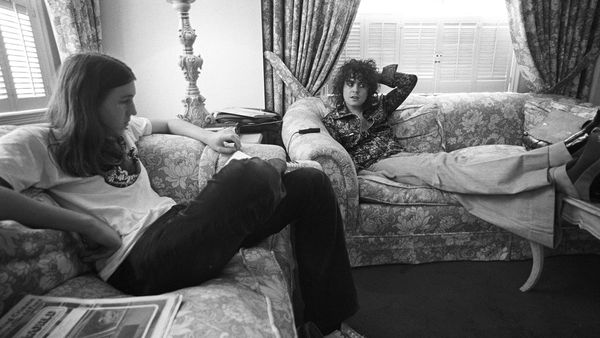In my wide-ranging conversation with Ethan Silverman we discuss why he is indebted to Cameron Crowe, Hal Willner’s work on Kurt Weill, the gift from producer Bill Curbishley of Def Leppard’s Joe Elliott, Cole Porter, Danny Fields, Beth Orton, Joan Jett, David Bowie, Nick Cave, Snarky Puppy, and Ethan’s interest in Weill, Lotte Lenya, and Bauhaus projects. On-camera comments by Billy Idol, Bono, The Edge, Elton John, Nena, Ringo Starr, Gloria Jones, Rolan Bolan, Richard Barone, Tony Visconti, Bowie, and Crowe provide unique context on the cultural importance of Marc Bolan.
![Ethan Silverman with Anne-Katrin Titze: “Hal Willner created probably one of my top five favourite albums of all time. It was called Lost In The Stars [: the Music of Kurt Weill] …”](/images/newsite/Ethan_Silverman_Anne-Katrin_Titze_225.jpg) |
| Ethan Silverman with Anne-Katrin Titze: “Hal Willner created probably one of my top five favourite albums of all time. It was called Lost In The Stars [: the Music of Kurt Weill] …” |
The T. Rex covers are by U2 (Bang A Gong (Get It On)), John Cameron Mitchell (Diamond Meadows), Macy Grey (Children of the Revolution), Lucinda Williams (Life's a Gas), Devandra Banhart Scenescoff), Kesha (Children of the Revolution), Maria Mckee (She Was Born to Be My Unicorn / Ride a White Swan), Snarky Puppy (The Slider), The Orwells (The Slider), Borns (Dawn Storm), Off Bloom (Solid Gold Easy Action), Beth Orton (Hippy Gumbo), Joan Jett (Jeepster), Nick Cave (Cosmic Dancer), and The Marc Bolan School of Music (Children Of The Revolution).
The artists and songs featured in Ethan Silverman’s engaging and creatively collaborative Angelheaded Hipster: The Songs of Marc Bolan & T. Rex, under the musical direction of Hal Willner (recently Dayna Goldfine and Dan Geller’s Hallelujah: Leonard Cohen, A Journey, A Song and the Lou Reed: Caught Between The Twisted Stars exhibition) resurrect the icon in all his glory.
A nice touch in the end credits is the studio musicians being shown and named. Here they are: Val McCallum Guitar, Jeff Babko Piano, Pete Thomas Drums, Steve Weisberg Arranger/Conductor, Tony Scherr Bass, Marc Ribot Guitar, Thomas Bartlett Arranger/Piano, Jim White Drums, Tom Fowler Bass (electric), Bill Frisell Guitar, Josiah Steinbrick Vibes, Ches Smith Drums, and an I’ll Be Seeing You remembrance of Hal Willner.
Maxwell Anderson and Kurt Weill told us in their September Song about the young girls “early in the spring” responding “with words and a clover ring” to musical courtship. This documentary picks up from there to explore why this demographic was so fascinated by Marc Bolan and all he was able to represent for them.
From New York City, Ethan Silverman joined me on Zoom for an in-depth conversation on Angelheaded Hipster: The Songs of Marc Bolan & T. Rex, a highlight of the 21st edition of the Tribeca Film Festival.
Anne-Katrin Titze: That’s quite a background you have there!
Ethan Silverman: That’s our new poster. Do you like it?
AKT: I do. It looks good with you in the middle too.
ES: I need Marc looking over my shoulder.
AKT: What was the first encounter in your life with Marc Bolan?
ES: My first encounter was late in life. I knew a couple of songs from the radio but I did not know Marc Bolan. I was encouraged by my producing partner in this project, Bill Curbishley, to listen more carefully to the music. So really, my first encounter was the music, the songs, and that’s what drove me. So what you see or saw is my own journey.
AKT: The person who accompanies this journey is Hal Willner. He is commenting with his expressions on the different renditions. This morning I was at the press preview for the Lou Reed exhibition at the Library for the Performing Arts. And there was Hal Willner’s widow, Sheila Rogers, who reconstructed his studio for the exhibit. Tell me about your Hal Willner connection!
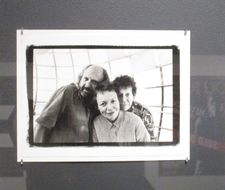 |
| Photograph by Guido Harari of Hal Willner, Laurie Anderson and Lou Reed at the Library for the Performing Arts Lou Reed: Caught Between The Twisted Stars exhibition Photo: Guido Harari |
ES: I had this idea to make an album. I’m not a record producer, I’m not a musician, I’m not an engineer, I just know a lot of musicians and I love music. And I have worked with many musicians and producers. So when we got the go-ahead to make an album, we had to find a producer, someone who was exciting, interesting. Hal Willner created probably one of my top five favourite albums of all time. It was called Lost In The Stars [: the Music of Kurt Weill], which is a recreation of Kurt Weill music. I was obsessed with that album. And when someone at the record company, Kate Hyman suggested Hal Willner, I just wanted to meet him. I was such a big fan of Lost in the Stars
AKT: Kurt Weill, it’s wonderful.
ES: Do you know this album?
AKT: Yes, I do.
ES: So we met and he made me laugh and he was wonderful. At first he was just going to advise on the album and then I think he got obsessed too. It was really a strange way to go, except he knows about rock’n’ roll, he worked with Lou Reed for 15 years as a producer.
AKT: Laurie Anderson, who was there this morning, said Hal was Lou’s best friend. The making of this album is structuring the film with different musicians reinterpreting the past in a way. There was also many years ago a Cole Porter album that did the same thing.
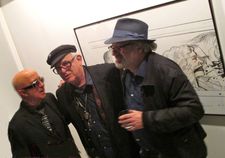 |
| Paul Shaffer and Ralph Steadman with Hal Willner at the For No Good Reason reception, hosted by Sony Pictures Classic Photo: Anne-Katrin Titze |
ES: I don’t think Hal did the Cole Porter. I think it was called Red Hot + Blue. That was excellent. I loved that record. I like that idea. Those albums have always inspired me, even though they are not always commercially successful. The Cole Porter was. I only got the money for the record because I had the idea to film it. Because everything is so visual these days. Then the film turned it into something much bigger than I had planned. When I started researching the archival I was so excited thinking how I could put those two things together.
AKT: There are some wonderful moments that go beyond the music. Beth Orton talking about how even as a little girl she knew what sexy was. Later the topic returns: No, young girls don’t like big hairy men.
ES: I’m only as good as the talent I get. I’m only as good as Hal Willner and Beth Orton and Danny Fields. Beth has one of my two favorite lines in the film, in which she says “I’m a songwriter, I’m a singer, but I can’t imagine what it would be like to be that free. I can only imagine it.” That’s how I feel about Marc Bolan. I love what Beth said there and how she said it. The thing about the sexuality was that Danny Fields who did that interview with me was my boss when I first started in New York. He discovered and was the manager of The Ramones. During the Seventies he was the co-editor of 16 magazine. That was at the height of the teenybopper fangirl/boy thing.
 |
| Hal Willner’s widow Sheila Rogers at the press preview for Lou Reed: Caught Between The Twisted Stars Photo: Anne-Katrin Titze |
And Marc Bolan who’s a serious musician got caught up in that. With Donny Osmond and The Partridge Family, all of that stuff in his office. And Danny had this whole theory about sexuality and rock ’n’ roll and how girl fans really made it successful. He didn’t want to be interviewed about someone he didn’t really know, but he’s in so many of these documentaries. Then I said “Let’s talk about the fans!” He said “That I know a lot about, that I’d like to talk to you about.” So I spoke to Danny specifically about that subject. And on their own, Beth Orton and Joan Jett really wanted to talk about their sexual awakening with Marc. The femininity of his was why they were so attracted to him.
AKT: It’s appealing but it’s not threatening. It’s not someone who is going to attack you. And that is a big part of teenage sexuality, you don’t want to get yourself in danger of being attacked so you can allow your own desire. It’s beautifully expressed; not many music documentaries go there.
ES: Thank you. Thank you for saying that. You know, I’m glad it came from women in the film and I’m glad that you’ve had this reaction, because these are very tricky times. And sexuality and rock ’n’ roll are very common but strange and dangerous bedfellows. I wanted to talk about it in the film and I’m glad that you as a woman appreciated that. Thank you.
AKT: On another, maybe not so different note, Cameron Crowe is a great interview. When he describes driving around L.A. and T. Rex was the coming thing and so fresh. There’s a visceral sense of the “freshness”, of how new it was. He also explains so well the “wounded bravado” of being big, but not that big in America.
ES: Let me tell you something about Cameron Crowe. When I was doing research and I saw that picture, the article he did for Creem Magazine, I said, oh I can get to Cameron Crowe! Because he actually interviewed him. We had met once briefly. He was one of the first interviews for the film and I knew I was going to be okay once I had that interview. He came to the interview completely prepared. He came with the original transcript that he had typed out when he was 17. It had coffee stains on it! He had read it the night before and he had asked me what I wanted to talk about with him and I wrote two pages. He did his homework and yet the conversation was completely free, completely open. But he was so prepared and so serious about it; it was a gift. I am indebted to Cameron.
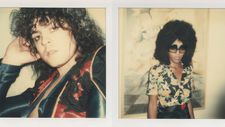 |
| Marc Bolan with Gloria Jones, the parents of Rolan Bolan |
AKT: Apropos coming with a transcript, the copying out of a whole book of poetry - that is a wonderful moment in the film. You show the library with the two books, including the one that the 11-year-old boy copied by hand.
ES: I walked into a joyous moment. Bill Curbishley was at the Royal Albert Hall in London. There was a line-up of stars doing some benefit. And Bill knew Joe Elliot, he ran into his dressing room before the show to say hi. He said “Bill come in, what are you doing?” He said “I’m making a documentary about T. Rex.” And he said “T. Rex? I have to be in it.” And Bill said “Well, the director is in New York.” He said “No, no let’s do it right now.” He got someone from his crew to come in with a camera and do it right there.
And Bill sent me a drive and said “If you want it, you can use it.” I couldn’t believe it. When I looked at that interview, I said this is a gift from the gods. Just the way he spoke, the passion. And then the editor said to me, I bet he still has that notebook, you’ve got to find it. I said “There’s a pandemic, how am I going to find it?” And he said “Ethan, find it!” And we wrote him and said “You wouldn’t happen to have it?” He said “I do. Why? Do you want me to shoot it? My wife [Kristine Wunschel] will do it!” This film was made with that kind of love and grit, really.
AKT: David Bowie and Marc Bolan were getting clothes from the dumpster!
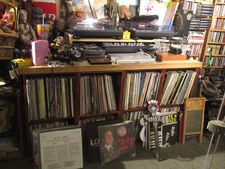 |
| Hal Willner’s studio in Lou Reed: Caught Between The Twisted Stars Photo: Anne-Katrin Titze |
ES: That was a discovery! I knew David Bowie many many years ago when I was 19. I am just so heartbroken that a) I never saw him again and b) didn’t get him for the film. I know what he’s like to talk to. He is as accessible as all the people were to making the film.
AKT: I once sold David Bowie books. I was working at Shakespeare and Company in Paris when he and Iman came in and were buying lots of second-hand books. They wanted a bag and Shakespeare, even a long time ago in the Nineties, didn’t have any. I had a terribly crumpled-up Monoprix plastic supermarket bag; it was shameful. And David Bowie was so gracious and kind and said “Oh that’s great, give me that crumpled plastic bag.”
ES: He was great. He was a great guy and people don’t know that.
AKT: Nick Cave says he thought Marc Bolan was a better writer than Bowie.
ES: That’s his opinion. He said it. He knows it’s in the film.
AKT: Were you surprised by that?
ES: I knew I had something incredible on camera when he said it. I’m a major David Bowie fan. I’m sure Nick Cave is as well.
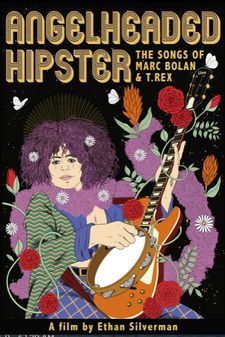 |
| Angelheaded Hipster: The Songs Of Marc Bolan & T. Rex poster |
AKT: You don’t want them competing with each other?
ES: I don’t think they need to compete. I think Marc deserves more than he has gotten. David Bowie is a major artist, major person, songwriter, presence. But so was Marc. Marc was bigger than Bowie at one point in the UK but he didn’t get what David did in the rest of the world.
AKT: Definitely not the name recognition, no. Some of the locations you chose are interesting. Snarky Puppy is playing on a rooftop in Brooklyn.
ES: Yes, what happened there is, I didn’t know Snarky Puppy.
AKT: I didn’t either, but I love the name and I like them now.
ES: They have a very big international following, which I also didn’t know. But a friend of mine met them, saw them and she said you must come with me to the Snarky Puppy concert. It was really pushing it, I went way out in Queens to a college. First of all, it was a large venue completely sold out. I spoke to some people during the intermission who had flown up from Puerto Rico just for the night.
At the concert I was blown away by them and by their musicianship. Backstage I met the leader of the band and I said “I’m starting a project on T. Rex” and he said “Oh cool.” I said, “I’ll make a barbecue and we will film it and you perform a song.” And they said “Yeah, we’ll do it.” It was like that. I knew that a film in which all the performances were in claustrophobic studios could get claustrophobic. And I wanted to open up the film and I knew we needed to breathe. And of course I remembered the Beatles concert on the roof. I said let’s give it a shot and it worked. They picked the right song, we filmed it well. And I was right, it opened up the film. When you need that oxygen, you get it.
AKT: One more point about your decision-making. We see at one point family photos but you do not very much go into Marc Bolan, the son. You go into Marc Bolan, the father, much more. How did that decision come about?
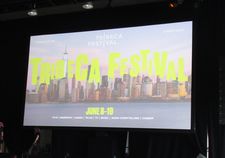 |
| Angelheaded Hipster: The Songs of Marc Bolan & T. Rex had its world premiere at the Tribeca Film Festival Photo: Anne-Katrin Titze |
ES: The decision came about because I was pressured and then decided to make a 95 minute film. I said I don’t have enough time to tell every detail of his life but I want to convey something. I’m going to do it expressionistically with the Cosmic Dancer song. By the way, those pictures came from his brother. I got them very late. I got them a month ago. I wanted to tell parts of this story through poetry, through music. I felt it was not that kind of biography, I was not going for that in that film but how can I leave out his childhood in the East End and his family and the fact that they were Jewish? I thought I’m going to try it this way. It was a directorial decision.
AKT: Do you know if there are any good Kurt Weill documentaries?
ES: No, but I’m the one who has to do it.
AKT: I think you should.
ES: I did many years ago write a treatment for a Lotte Lenya film. It was for a producer and a wonderful German cinematographer was going to direct it. And then they didn’t ever do it. But I wrote a treatment for it. I should look it up. I’ve done my Kurt Weill/Lotte Lenya research.
AKT: If you need any help with that, I’d be onboard for a Kurt Weill project.
ES: Are you German?
AKT: Yes.
ES: So you’re fluent in German?
AKT: I’m fluent in German, absolutely.
ES: I’ll find you then. I’m also obsessed with a few German things, the other being Bauhaus.
AKT: So let’s work on some German projects. Very nice to meet you!
ES: Yes! And very nice to meet you. And thank you for the opportunity to talk about the film.








